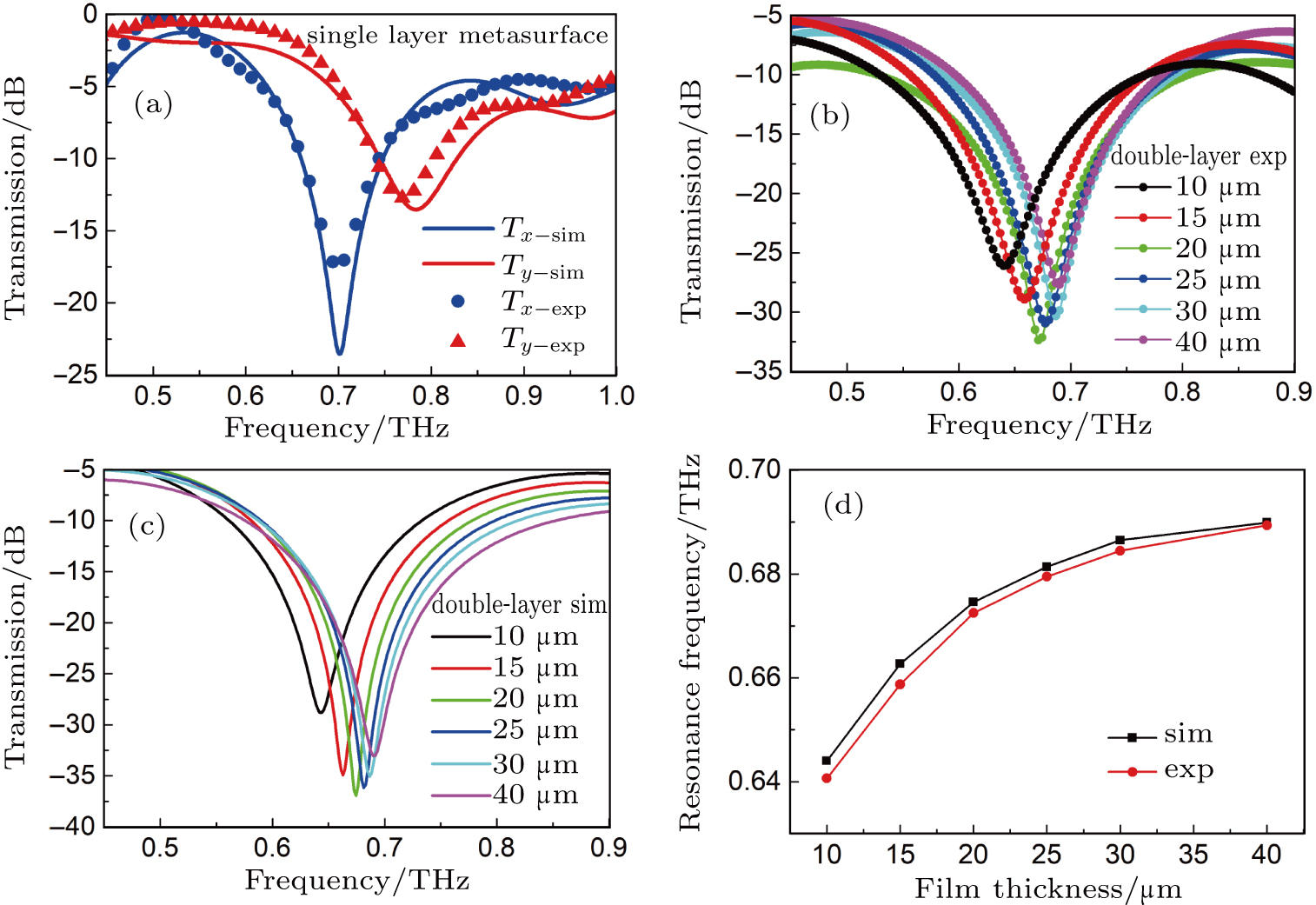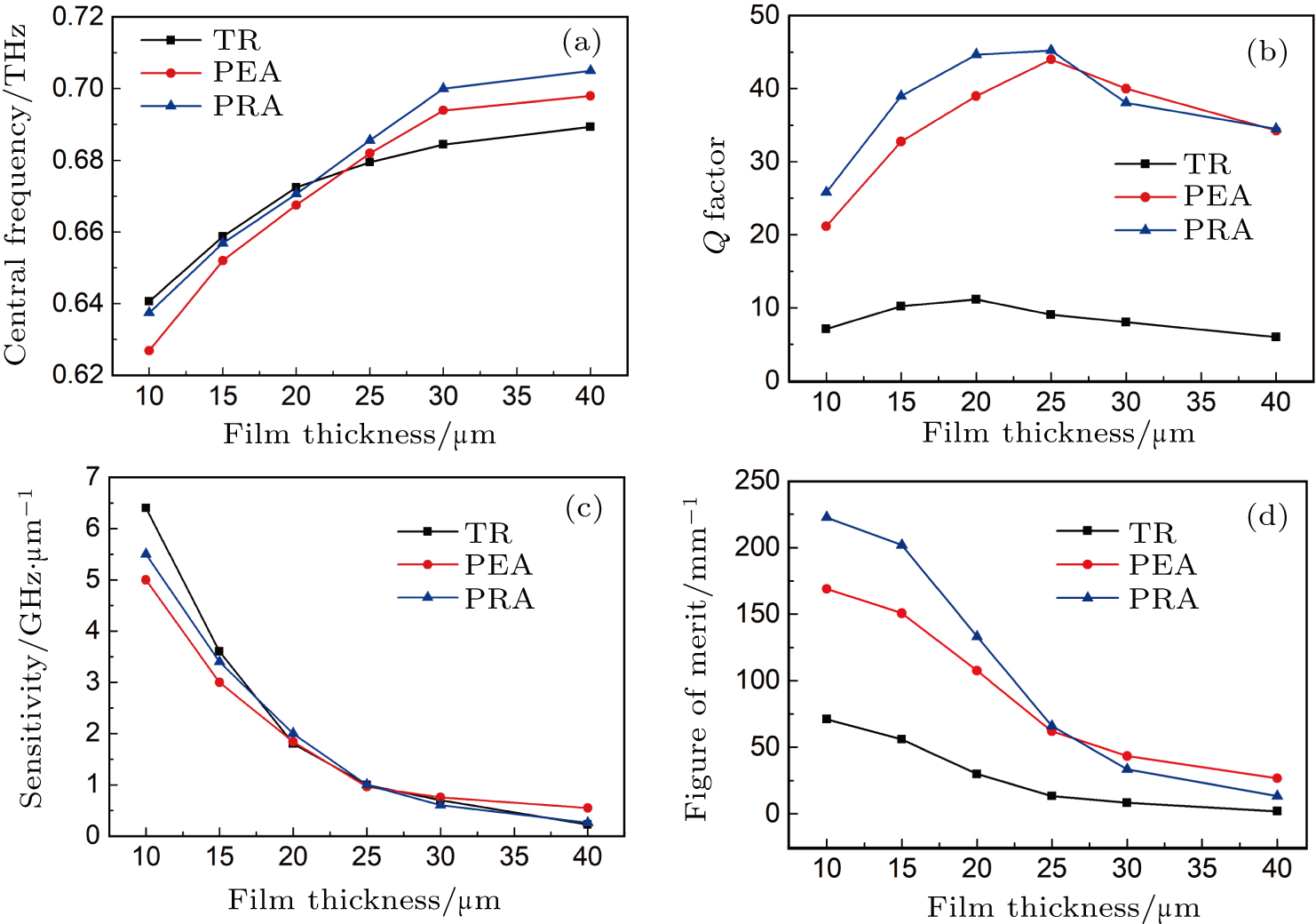† Corresponding author. E-mail:
Project supported by the National Key Research and Development Program of China (Grant No. 2017YFA0701000), the National Natural Science Foundation of China (Grant Nos. 61971242, 61831012, and 61671491), the Natural Science Foundation of Tianjin City, China (Grant No. 19JCYBJC16600), and the Young Elite Scientists Sponsorship Program by Tianjin, China (Grant No. TJSQNTJ-2017-12).
The terahertz (THz) resonance, chirality, and polarization conversion properties of a double-layer chiral metasurface have been experimentally investigated by THz time domain spectroscopy system and polarization detection method. The special symmetric geometry of each unit cell with its adjacent cells makes a strong chiral electromagnetic response in this metasurface, which leads to a strong polarization conversion effect. Moreover, compared with the traditional THz transmission resonance sensing for film thickness, the polarization sensing characterized by polarization elliptical angle (PEA) and polarization rotation angle (PRA) shows a better Q factor and figure of merit (FoM). The results show that the Q factors of the PEA and PRA reach 43.8 and 49.1 when the interval film is 20 μm, while the Q factor of THz resonance sensing is only 10.6. And these PEA and PRA can play a complementary role to obtain a double-parameter sensing method with a higher FoM, over 4 times than that of resonance sensing. This chiral metasurface and its polarization sensing method provide new ideas for the development of high-efficiency THz polarization manipulation, and open a window to the high sensitive sensing by using THz polarization spectroscopy.
The terahertz (THz) wave generally refers to the electromagnetic wave whose frequency is in the range of 0.1 THz to 10 THz between the microwave and infrared radiation. The THz technology has promising application potentials for its unique advantages, especially in the imaging,[1] sensing,[2] and communication.[3,4] The application of terahertz technology is inseparable from various functional devices. Among them, THz polarization optic devices, such as polarization converters and rotators are in urgent demand. Traditional polarization converters rely on the anisotropy of bulk materials to realize the phase retardation and polarization control.[5] However, most of materials in nature are lack of notable birefringence or optical activity in the THz regime, so the artificial metasurfaces have been paid much attention in THz polarization devices.[6–8]
Metasurfaces are artificial electromagnetic structures consisting of orderly arranged plane elements, which can manipulate amplitude, phase, and polarization of waves in space and time domain.[9–11] When the cell structure of metasurface has geometric chirality, it will have chirality for electromagnetic waves with the proper wavelength, which is similar to the medium composed of chiral molecules.[12] Chiral metasurface can break the mirror symmetry, realize polarization conversion and asymmetric one-way transmission.[13] The macroscopic physical phenomenon of chiral medium is optical activity (OA),[14] where there are the different propagation constants for the two orthogonal chiral photonic states: left circularly polarized (LCP) light and right circularly polarized (RCP) light.[15] The difference in propagation speeds and absorptions of LCP and RCP makes polarization rotation and circular dichroism, respectively, which lead to the polarization conversion and selection.[16] By designing the proper structures and symmetry, the metasurface can obtain strong electromagnetic chirality and achieve efficient polarization conversion.
In recent years, the chiral metasurfaces in the THz band have received extensive attention. Liu et al.[17] designed a single-layer chiral metasurface can realize broadband polarization conversion in THz region, the polarization conversion rate can reach 90%, but the transmittance is very low. Cheng et al.[18] demonstrated a chiral metasurface structure based on bilayer wire-split-ring resonators, realized linear-to-circular and linear-to-linear polarization conversion for THz waves, with the polarization conversion rate exceeding 90%. In addition, Decker et al.[19] proposed a stacked and twisted split-ring resonators arranged in a C4 symmetric lattice, the eigenmodes are truly chiral and exhibits huge optical activity with a polarization rotation angle of 30°.
Metasurface also exhibits a strong localized resonance and enhancement on the fields, which can significantly improve the performance in sensing technology.[20–22] In recent years, many metasurfaces with different structures were proposed for THz sensors.[23–25] However, the present sensing mechanism is mainly based on its localized resonance effect of metasurface, and relies on monitoring the frequency shift of the resonance peak in the THz spectra caused by the changes of detected physical parameter. If we can utilize polarization conversion and selection effects of chiral metasurface, we can detect polarization parameters rather than the changes of the intensity spectrum for THz sensing, which may bring more information, higher sensitivity, and new physical perspective. However, the works related to THz sensing based on the polarization conversion of the chiral metasurface have rarely been reported yet.
In this paper, a double-layer chiral metasurface is demonstrated for THz polarization conversion and sensing. The THz resonance, chirality, and polarization conversion properties of a double-layer chiral metasurface have been experimentally investigated by THz time domain spectroscopy (THz-TDS) system and polarization detection method. The special symmetric geometry of each unit cell with its adjacent cells makes a strong chiral electromagnetic response in this metasurface, which leads to a strong polarization conversion effect. Moreover, compared with the traditional THz transmission resonance sensing for film thickness, the polarization sensing shows a better quality (Q) factor and figure of merit (FoM). This chiral metasurface and its polarization sensing method provide new ideas for the development of high-efficiency THz polarization conversion and high sensitive sensing.
Our proposed chiral metasurface consists of two layers of metallic subwavelength structures and one layer of polyvinyl alcohol (PVA) film sandwiched in the middle, as shown in Fig.
The PVA is an important nontoxic and biocompatible polymer, and has a high transmittance in the THz regime. The PVA film is coated on one of the metallic metasurfaces. First, the PVA solution is prepared by mixing the PVA particles with de-ionized water, the weight ratio is 1 : 8. The mixture needs to be heated to 80 °C and magnetic stirred for hours until completely dissolved. Then the PVA film is processed by spin-coating the solution onto the metasurface. The thickness of PVA film can be controlled by adjusting the spin speed, so as to adjust the distance between two layers of metasurfaces, and the thickness is accurately measured by profilometer. Figure
The THz-TDS system is used in the experiments at room temperature with the humidity of less than 5% as shown in Fig.
Firstly, the transmission properties of the single-layer metasurface have been studied when the THz polarizer was rotated at 0°. When we rotate the metasurface at 0° and 90°, it is defined that the x-LP and y-LP incident transmissions of the metasurface are detected in the experiment, respectively. Figure
Next, we investigate the transmission spectra of the double layer chiral metasurface with x-LP incidence. Figures
To investigate the physical mechanism of the double-layer metasurface structure, the electric field distributions are simulated in Fig.
To obtain the complete polarization state in the experiment, the THz polarizer behind the sample is rotated to detect the +45° and −45° LP components as shown in Fig.

Furthermore, the amplitude and phase of two orthogonal LP signals were processed to obtain two important polarization parameters, i.e., the polarization elliptical angle (PEA) ε and polarization rotation angle (PRA) ψ, which can be derived as follows:


The PEA and PRA spectra both in simulation and experiment are shown in Fig.
 | Fig. 5. Simulative (a) PEA and (b) PRA spectra, experimental (c) PEA and (d) PRA spectra of the double-layer chiral metasurface with different film thicknesses. |
The terminal trajectory equation of electric vector E, also called as polarization ellipse, can be obtained as follows:

Finally, we discuss the THz polarization sensing performance based on this double-layer chiral metasurface compared with the traditional THz resonance sensing method. Three physical sensing parameters are considered: LP transmission resonance (TR) peak shown in Fig.



Figure
FoM indicates a comprehensive performance of the sensor, the detected sample and the measuring system. Figure
Furthermore, the sensing limitations of different sensing methods are discussed here. The sensing sensitivity of the sensor depends on the minimum frequency shift that the THz-TDS system can distinguish. However, the accuracy of the detected film thickness depends not only on the sensing measurement system, but also on the sensitivity of the sensor and the characteristics of the tested samples. According Eqs. (
In conclusion, we have fabricated a double-layer chiral metasurface with a PVA film as interval between two layers of spiral metallic structures, and demonstrated that this metasurface can be applied in THz polarization conversion and sensing for film thickness by THz-TDS system and polarization detection method. The special symmetric geometry of each unit cell with its adjacent cells makes a strong chiral electromagnetic response in this metasurface, which leads to a strong polarization conversion effect. The chirality and polarization conversion performance of this chiral metasurface are characterized by PEA and PRA spectra. Moreover, compared with the traditional TR sensing, the polarization sensing characterized by PEA and PRA peaks shows a better Q factor and FoM, which is over 4 times than those of the TR sensing. And these PEA and PRA can play a complementary role in polarization sensing to obtain a double-parameter sensing method with a high FoM. This chiral metasurface and its polarization sensing method will provide new ideas for the development of high-efficiency THz polarization selection and manipulation, and open a window to the high sensitive sensing by using THz polarization spectroscopy.
| [1] | |
| [2] | |
| [3] | |
| [4] | |
| [5] | |
| [6] | |
| [7] | |
| [8] | |
| [9] | |
| [10] | |
| [11] | |
| [12] | |
| [13] | |
| [14] | |
| [15] | |
| [16] | |
| [17] | |
| [18] | |
| [19] | |
| [20] | |
| [21] | |
| [22] | |
| [23] | |
| [24] | |
| [25] | |
| [26] | |
| [27] |







